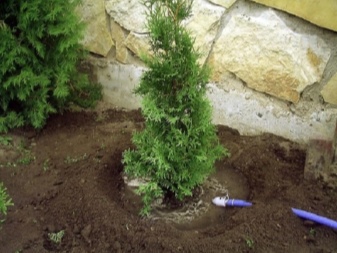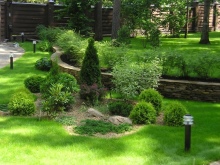Dwarf thuja: varieties, tips for choosing, planting and care

Among conifers, thuja are especially popular. An increasing number of homeowners are planting small-sized ornamental evergreen shrubs that become a real decoration of any home garden. We will talk about the features of such plants, the rules for planting them and the principles of care in our material.

general characteristics
Dwarf thuja is a common evergreen coniferous plant. Speaking about the biological origin of the plant, it should be noted that it belongs to the cypress family. Miniature evergreen shrubs are very popular among gardeners; they are often used as ornamental plants for decorating backyard areas. However, the positive characteristics of thuja are not limited only to its appearance. The plant has favorable properties that can have a positive effect on the human body as a whole. So, thuja purify the air. The plant is rather picky about leaving, so its maintenance will be within the power of not only an experienced gardener, but also beginners.

Varieties
Today, there are several varieties of low-growing thuja, which are popular not only among gardeners, but also among landscape designers. Let's take a closer look at the most popular varieties of miniature plants.
- Danica. A distinctive feature of this variety is its unusual shape. So, the dwarf thuja "Danica" has the shape of an almost perfect ball, the diameter of which is about 1 meter. The bushes are very fluffy, so the plants are often used to decorate garden plots, as well as public areas for various purposes.
- Little Champion. Tui, which belong to this subspecies, have an unusual cone-shaped crown of a branchy type. That is why these shrubs more often than others become part of the so-called alpine hills. It is interesting to note that thuja "Little Champion" has a unique ability to change the color of the crown depending on the season. So, during the warm seasons, the plant has beige or brown needles, while in winter the color of the plant becomes bronze.
- Tiny Tim. This variety is considered one of the smallest, because the diameter of the bite is only 0.5 m. It is worth noting that "Tiny Tim" grows rather slowly. The plant reaches the specified mark of 50 centimeters only after 10 years.
- Globoza Nana. Globoza Nana attracts many landscape designers due to its unusual and bright yellow-green crown color. In addition, the shape of the needles of the plant is rather unusual and resembles scales.




Regardless of the specific variety you choose, it is important to remember that the plant needs not only proper planting, but also proper care. In order for it to remain healthy, grow and develop for a long time, it is necessary to follow all the rules, instructions and recommendations offered by specialists.
How to choose?
Choosing a dwarf thuja is a task that needs to be approached with all seriousness and care. First of all, experienced gardeners recommend deciding on which site and in which specific place you will plant the plant, since when choosing a seedling, you should take into account all the features of the soil, as well as the amount of sunlight that the miniature plant will be exposed to. As for the direct selection of a seedling, it is necessary to take into account such characteristics as photophilousness, resistance to low temperatures and care requirements.
The moment you choose a particular plant, it is important to carefully examine its appearance. Make sure that the thuja has no defects, because they can cause disease and death of the plant. In addition, non-standard indicators can disrupt your plans for decorating a site with this plant. Make sure the root system of the seedling you are purchasing is well developed and not chopped off. Otherwise, the plant will not take root.
It is important to make sure that the upper layers of the root and trunk are not flaky or overdried. In addition, the crown deserves attention.


Landing
According to popular belief, dwarf thuja can be planted in your garden or summer cottage at any time of the year - in this regard, there are no restrictions at all. To be 100% sure that the plant will take root, it is best to plant it in the fall or early spring. During the planting process, it is important to ensure that the root collar of the miniature thuja is flush with the ground. You cannot raise it high or immerse it deeply - this will lead to the occurrence of diseases in the plant.
To prevent decay processes that can occur if there are places with stagnant water on your site, you should provide a drainage system for the thuja. To do this, gravel or broken brick should be laid out at the bottom of the groove where you will place the seedling. Please note that the height of such a layer should be about 20 centimeters.
If you plan to plant several miniature thujas in a row, then you should keep in mind that the distance between them should be at least 100 centimeters.



How to care?
First of all, it is worth remembering that watering is considered the main care measure for dwarf thuja. It should be systematic and regular. So, during the first 30 days after direct planting, it is recommended to water the seedling once a week... At the same time, during one watering, it is necessary to apply to the soil not less than 10 liters of clean water. Remember that maintaining the required moisture level ensures active growth and development of the plant crown.
Important! If you planted a plant in a hot and arid climate, then the number of waterings should be doubled.


Besides watering, it is important to pay attention to loosening. So, during the first 3 years of thuja growth, loosening should be carried out near the plant trunk. However, this procedure should be done quite carefully (at a distance no deeper than 10 centimeters), otherwise irreparable damage to the root system can be caused. The mulching process is also important, during which peat or sawdust should be used. Mulching is recommended for 6-7 centimeters. And also one of the obligatory care measures is the prevention of damage to the crown of a small thuja during the cold period. To do this, tie low shrubs.
Important! It is recommended to prune the plant by more than one third. Use only a sharp secateurs for pruning.


Use in landscape design
Landscape designers most often use low thuja to create and design the so-called rock gardens, which are artificial compositions for decorating plots. In addition, small evergreen shrubs can be used for planting hedges or for decorating gazebos and flower beds.
And also, at your request, you can use thuja in combination with other plants, forming unique plant compositions.



For the varieties of tui, see the next video.



































































The comment was sent successfully.